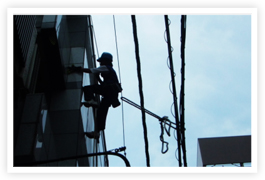2.4-3. Knowledge of technique (application of cleaning force)

2.4-3 Knowledge of technique (application of cleaning force)
For efficient cleaning, knowledge of technique such as contents and procedure of cleaning is necessary to effectively utilize cleaning force (chemical force and physical force).
To determine a cleaning method, the first thing to do is to examine "What kind of dirt is on where?" The next is to select cleaning force such as detergents and tools. Then you can choose the optimal cleaning technique that can effectively utilize the selected force.
Imagine you are just about to clean the tough greasy kitchen dirt. I suppose you would put detergent on and start brushing. It would not be an easy business, would it? But if you leave the detergent for a while and give its components time to resolve dirt, it only needs small physical force to remove the dirt, which makes the cleaning more efficient. Moreover, if you do other works such as cleaning the living room or the bathroom while you are letting the detergent do its work, your time-use is even more efficient. It should be noted, however, that there is a risk of damaging the architectural material if you leave the detergent too long.
The example above shows how you can make the cleaning more efficient by applying proper technique to cleaning force that you chose. Furthermore, if you finish up by putting anti-dirt coating on the cleaned architectural material, it will reduce frequency and hardship of your cleaning.
★ Steps to decide cleaning technique
(1) "Decide contents of work according to work categories" (2) Apply "basic procedure of cleaning" to (1) and design the overall process of implementation.
(1) Decide contents of work according to the work categories
Based on the result of the examination of "what kind of dirt is on where", we decide contents of work that can effectively utilize cleaning force (chemical force and physical force) while taking into account the characteristics of work categories. Works can be categorized according to architectural materials, dirt, site, and location. For instance, if we decide cleaning technique according to the types of architectural material, we could say "cleaning technique for tiles." If we decide cleaning technique according to the types of dirt, we could day "cleaning technique for greasy dirt." To reiterate, if we categorize works according to factors such as architectural material, dirt, site, and location, we can think more clearly about cleaning technique. For your information, you can find the cleaning technique that suits your purpose by searching in the Internet with the search words "cleaning technique for -----.".Many websites have information that would help you.




※ e.g. The architectural material is stainless steel. Dirt is greasy dirt. The site is wall (high-place). The location is kitchen. Your cleaning technique should correspond to these criteria. You need to choose detergents and tools that are effective for the greasy dirt and would not damage the stainless steel that is easily scarred. Moreover, your cleaning technique should be usable for high-place work, and safety measure needs to be implemented.

(2) basic procedure of cleaning
By applying basic procedure of cleaning to ① and designing the overall workflow and methods of implementation, you can make your cleaning more efficient. The procedure I am going to introduce next is only a basic guide that is to be adjusted to each house's actual condition.
1) procedure of implementation
If you think of a building as space, cleaning procedure will be shaped as follows. If the building is two storied, start from upper stairs. It is because dust and dirt falls down by gravity. In terms of the size of space, it is desirable to clean small space before large space. In terms of the direction of movement, you can prevent re-contamination by cleaning from the rear to the front entrance. From different reasons like these, there is a basic procedure to do the cleaning efficiently.

2) Procedure by sites
If you divide a house into parts, the basic of cleaning procedure is from top to bottom. As dust and dirt falls down, this rule is to prevent re-contamination after the cleaning. Cleaning proceeds from ceiling's architectural material and electric appliances, then to wall's architectural material and door and window sash, then finally to furniture and the floor.

3) Procedure by locations
If you segment a house by locations, you need to consider each location's hygienic issue. This consideration makes a kitchen the first to be cleaned since it is the location where food is cooked. By doing kitchen first, we can also prevent bringing dirt from other locations into the place where hygiene is the most imposing issue. After the kitchen, the desirable order of work is the living room, the bathroom, the toilet, and the entrance.

NEXT

